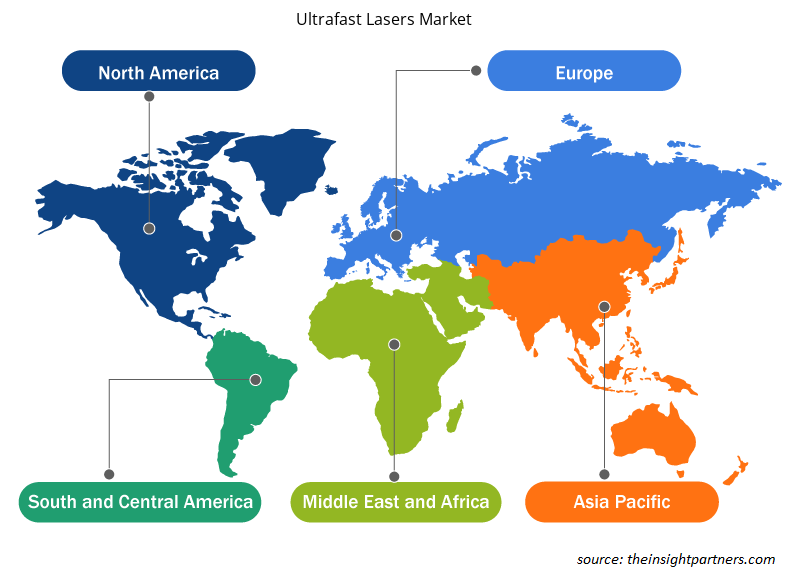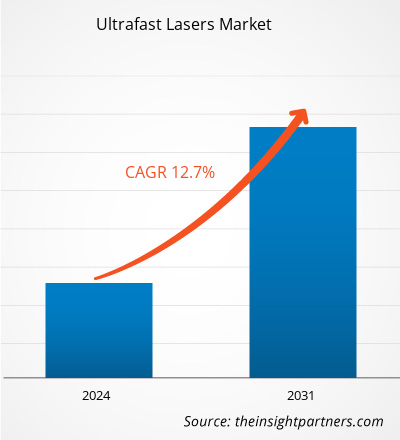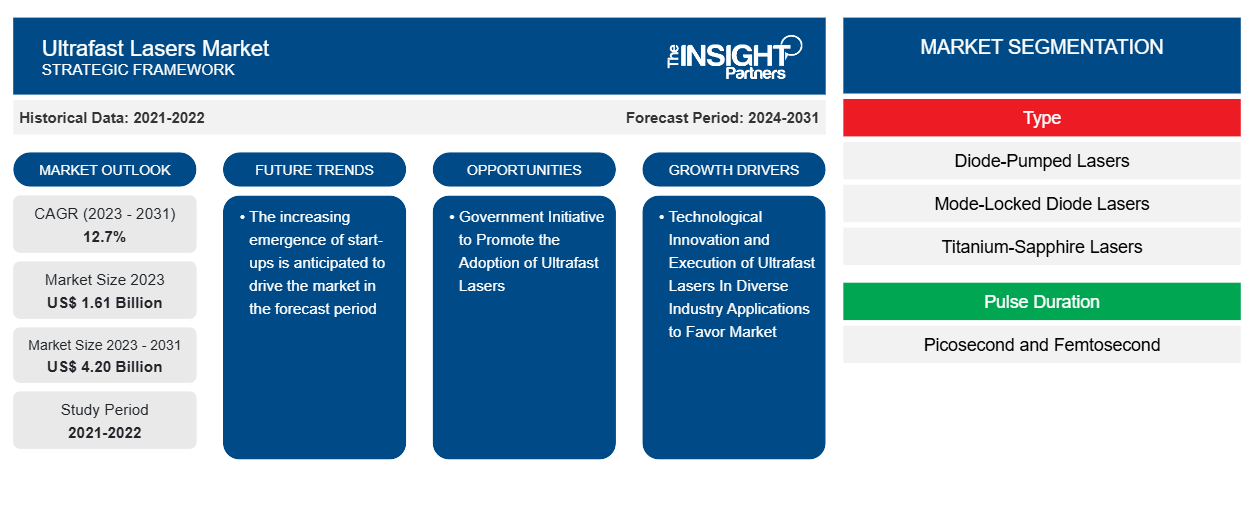Se prevé que el tamaño del mercado de láseres ultrarrápidos alcance los 4.200 millones de dólares en 2031, frente a los 1.610 millones de dólares en 2023. Se espera que el mercado registre una CAGR del 12,7 % durante el período 2023-2031. Es probable que las crecientes innovaciones tecnológicas y la implementación de láseres ultrarrápidos en diversas aplicaciones industriales sigan siendo tendencias e impulsores clave en el mercado.
Análisis del mercado de láseres ultrarrápidos
El mercado de láseres ultrarrápidos está experimentando un crecimiento significativo a nivel mundial. Este crecimiento se atribuye a parámetros como el aumento de las innovaciones tecnológicas y la implementación de láseres ultrarrápidos en diversas aplicaciones industriales. Además, se prevé que la expansión de las aplicaciones de la tecnología láser y la creciente aparición de nuevas empresas supongan varias oportunidades para el mercado.
Descripción general del mercado de láseres ultrarrápidos
Los láseres ultrarrápidos se caracterizan por generar pulsos de luz muy cortos, comúnmente del orden de femtosegundos o picosegundos. Los láseres ultrarrápidos se basan en técnicas como el bloqueo de modos para formar un tren de pulsos y han tenido éxito recientemente debido a los nuevos avances en fotónica . Estos avances en la tecnología láser han permitido la generación de pulsos que van desde unos pocos femtosegundos hasta decenas de attosegundos.
Personalice este informe según sus necesidades
Obtendrá personalización en cualquier informe, sin cargo, incluidas partes de este informe o análisis a nivel de país, paquete de datos de Excel, así como también grandes ofertas y descuentos para empresas emergentes y universidades.
-
Obtenga las principales tendencias clave del mercado de este informe.Esta muestra GRATUITA incluirá análisis de datos, desde tendencias del mercado hasta estimaciones y pronósticos.
Impulsores y oportunidades del mercado de láseres ultrarrápidos
Innovación tecnológica y ejecución de láseres ultrarrápidos en diversas aplicaciones industriales para favorecer el mercado.
La innovación tecnológica y la ejecución de láseres ultrarrápidos en diversas aplicaciones industriales están impulsando el crecimiento del mercado. Los láseres ultrarrápidos se utilizan en industrias como la electrónica de consumo, la industrial, la automotriz, la médica y científica, entre otras. Los láseres ultrarrápidos pueden ser útiles para las necesidades de la industria automotriz. Esto comprende la estructuración de pequeños surcos en la superficie de la pared del cilindro de un motor de combustión. Esto garantiza una distribución completa del lubricante a lo largo de la pared del pistón para minimizar la pérdida de fricción. También presenta una revisión de los avances modernos en los procesos de fabricación basados en láser ultrarrápido, algunas de las aplicaciones industriales más interesantes y un debate sobre las tendencias y los desafíos futuros. Por lo tanto, considerando los parámetros anteriores, la creciente innovación tecnológica y la implementación de láseres ultrarrápidos en diversas aplicaciones industriales está impulsando el crecimiento del mercado de láseres ultrarrápidos.
Iniciativa gubernamental para promover la adopción de láseres ultrarrápidos.
Se prevé que el creciente número de iniciativas gubernamentales para promover la adopción de láseres ultrarrápidos ofrezca varias oportunidades para el mercado de los láseres ultrarrápidos. La formación de una próxima generación de talentos altamente cualificados es una cuestión crucial en varios campos, y la investigación no es una excepción. Basándose en su experiencia en las comunidades científicas y académicas, en abril de 2023, el NSERC puso en marcha un ambicioso proyecto para iniciar un ecosistema de aprendizaje sostenible en el campo de la ciencia y la tecnología de los láseres ultrarrápidos. El NSERC ofreció 1,65 millones de dólares para la próxima generación de talentos en el campo de la ciencia y la tecnología de los láseres ultrarrápidos.
Informe de mercado de láseres ultrarrápidos Análisis de segmentación
Los segmentos clave que contribuyeron a la derivación del análisis del mercado de láseres ultrarrápidos son el tipo, la duración del pulso y la aplicación.
- Según el tipo, el mercado de láseres ultrarrápidos se divide en láseres bombeados por diodos, láseres de diodos con bloqueo de modo, láseres de zafiro y titanio y láseres de fibra . Se prevé que el segmento de láseres bombeados por diodos tenga una participación de mercado significativa en el período de pronóstico.
- Según la duración del pulso, el mercado de láseres ultrarrápidos se divide en picosegundos y femtosegundos. Se prevé que el segmento de picosegundos ocupe una cuota de mercado significativa en el período de pronóstico.
- Por aplicaciones, el mercado está segmentado en electrónica de consumo, industrial, automotriz y médica y científica. Se prevé que el segmento de electrónica de consumo tenga una participación de mercado significativa en el período de pronóstico.
Análisis de la cuota de mercado de los láseres ultrarrápidos por geografía
El alcance geográfico del informe del mercado de láseres ultrarrápidos se divide principalmente en cinco regiones: América del Norte, Asia Pacífico, Europa, Medio Oriente y África, y América del Sur y Central.
América del Norte ha dominado el mercado de láseres ultrarrápidos. Las tendencias de adopción de alta tecnología en varias industrias de la región de América del Norte han impulsado el crecimiento de este mercado. Se espera que factores como la mayor adopción de herramientas digitales y el alto gasto tecnológico por parte de las agencias gubernamentales impulsen el crecimiento del mercado de láseres ultrarrápidos de América del Norte. Además, un fuerte énfasis en la investigación y el desarrollo en las economías desarrolladas de los EE. UU. y Canadá está obligando a los actores norteamericanos a traer soluciones tecnológicamente avanzadas al mercado. Además, los EE. UU. tienen una gran cantidad de actores del mercado de láseres ultrarrápidos que se han centrado cada vez más en el desarrollo de soluciones innovadoras. Todos estos factores contribuyen al crecimiento del mercado de láseres ultrarrápidos de la región.
Perspectivas regionales del mercado de láseres ultrarrápidos
Los analistas de Insight Partners explicaron en detalle las tendencias y los factores regionales que influyen en el mercado de láseres ultrarrápidos durante el período de pronóstico. Esta sección también analiza los segmentos y la geografía del mercado de láseres ultrarrápidos en América del Norte, Europa, Asia Pacífico, Oriente Medio y África, y América del Sur y Central.

- Obtenga datos regionales específicos para el mercado de láseres ultrarrápidos
Alcance del informe sobre el mercado de láseres ultrarrápidos
| Atributo del informe | Detalles |
|---|---|
| Tamaño del mercado en 2023 | 1.610 millones de dólares estadounidenses |
| Tamaño del mercado en 2031 | US$ 4.20 mil millones |
| CAGR global (2023 - 2031) | 12,7% |
| Datos históricos | 2021-2022 |
| Período de pronóstico | 2024-2031 |
| Segmentos cubiertos |
Por tipo
|
| Regiones y países cubiertos |
América del norte
|
| Líderes del mercado y perfiles de empresas clave |
|
Densidad de actores del mercado de láseres ultrarrápidos: comprensión de su impacto en la dinámica empresarial
El mercado de láseres ultrarrápidos está creciendo rápidamente, impulsado por la creciente demanda de los usuarios finales debido a factores como la evolución de las preferencias de los consumidores, los avances tecnológicos y una mayor conciencia de los beneficios del producto. A medida que aumenta la demanda, las empresas amplían sus ofertas, innovan para satisfacer las necesidades de los consumidores y aprovechan las tendencias emergentes, lo que impulsa aún más el crecimiento del mercado.
La densidad de actores del mercado se refiere a la distribución de las empresas o firmas que operan dentro de un mercado o industria en particular. Indica cuántos competidores (actores del mercado) están presentes en un espacio de mercado determinado en relación con su tamaño o valor total de mercado.
Las principales empresas que operan en el mercado de láseres ultrarrápidos son:
- Sistemas de amplitud
- Coherente Inc.
- Láser Dpss Inc.
- Femtolasers Productions GmbH
- Fianiijm Ltd
- Láser Huaray
Descargo de responsabilidad : Las empresas enumeradas anteriormente no están clasificadas en ningún orden particular.

- Obtenga una descripción general de los principales actores clave del mercado de láseres ultrarrápidos
Noticias y desarrollos recientes del mercado de láseres ultrarrápidos
El mercado de láseres ultrarrápidos se evalúa mediante la recopilación de datos cualitativos y cuantitativos a partir de una investigación primaria y secundaria, que incluye publicaciones corporativas importantes, datos de asociaciones y bases de datos. A continuación, se enumeran algunos de los avances en el mercado de láseres ultrarrápidos:
- MKS Instruments, Inc. presentó su láser Spectra-Physics IceFyre FS IR200, un láser de femtosegundo industrial que ofrece una potencia de >200 W y una energía de pulso de >200 µJ con pulsos ultracortos de <500 fs en el infrarrojo (IR). (Fuente: MKS Instruments, Inc, sitio web de la empresa, junio de 2023)
- Chromacity anunció un acuerdo de asociación estratégica con Edmund Optics para el suministro y la distribución global de sus láseres ultrarrápidos. El anuncio coincide con el lanzamiento del último láser ultrarrápido de Chromacity que emite luz a 920 nm. (Fuente: sitio web de la empresa Chromacity, febrero de 2024)
Informe sobre el mercado de láseres ultrarrápidos: cobertura y resultados
El informe “Tamaño y pronóstico del mercado de láseres ultrarrápidos (2021-2031)” proporciona un análisis detallado del mercado que cubre las siguientes áreas:
- Tamaño del mercado de láseres ultrarrápidos y pronóstico a nivel global, regional y nacional para todos los segmentos de mercado clave cubiertos bajo el alcance.
- Tendencias del mercado de láseres ultrarrápidos, así como dinámica del mercado, como impulsores, restricciones y oportunidades clave.
- Análisis detallado PEST/Cinco fuerzas de Porter y FODA.
- Análisis del mercado de láseres ultrarrápidos que cubre las tendencias clave del mercado, el marco global y regional, los principales actores, las regulaciones y los desarrollos recientes del mercado.
- Análisis del panorama de la industria y la competencia que cubre la concentración del mercado, el análisis de mapas de calor, los actores destacados y los desarrollos recientes para el mercado de láseres ultrarrápidos.
- Perfiles detallados de empresas.
- Análisis histórico (2 años), año base, pronóstico (7 años) con CAGR
- Análisis PEST y FODA
- Tamaño del mercado, valor/volumen: global, regional y nacional
- Industria y panorama competitivo
- Conjunto de datos de Excel
Informes recientes
Informes relacionados
Testimonios
Razón para comprar
- Toma de decisiones informada
- Comprensión de la dinámica del mercado
- Análisis competitivo
- Información sobre clientes
- Pronósticos del mercado
- Mitigación de riesgos
- Planificación estratégica
- Justificación de la inversión
- Identificación de mercados emergentes
- Mejora de las estrategias de marketing
- Impulso de la eficiencia operativa
- Alineación con las tendencias regulatorias























 Obtenga una muestra gratuita para - Mercado de láseres ultrarrápidos
Obtenga una muestra gratuita para - Mercado de láseres ultrarrápidos